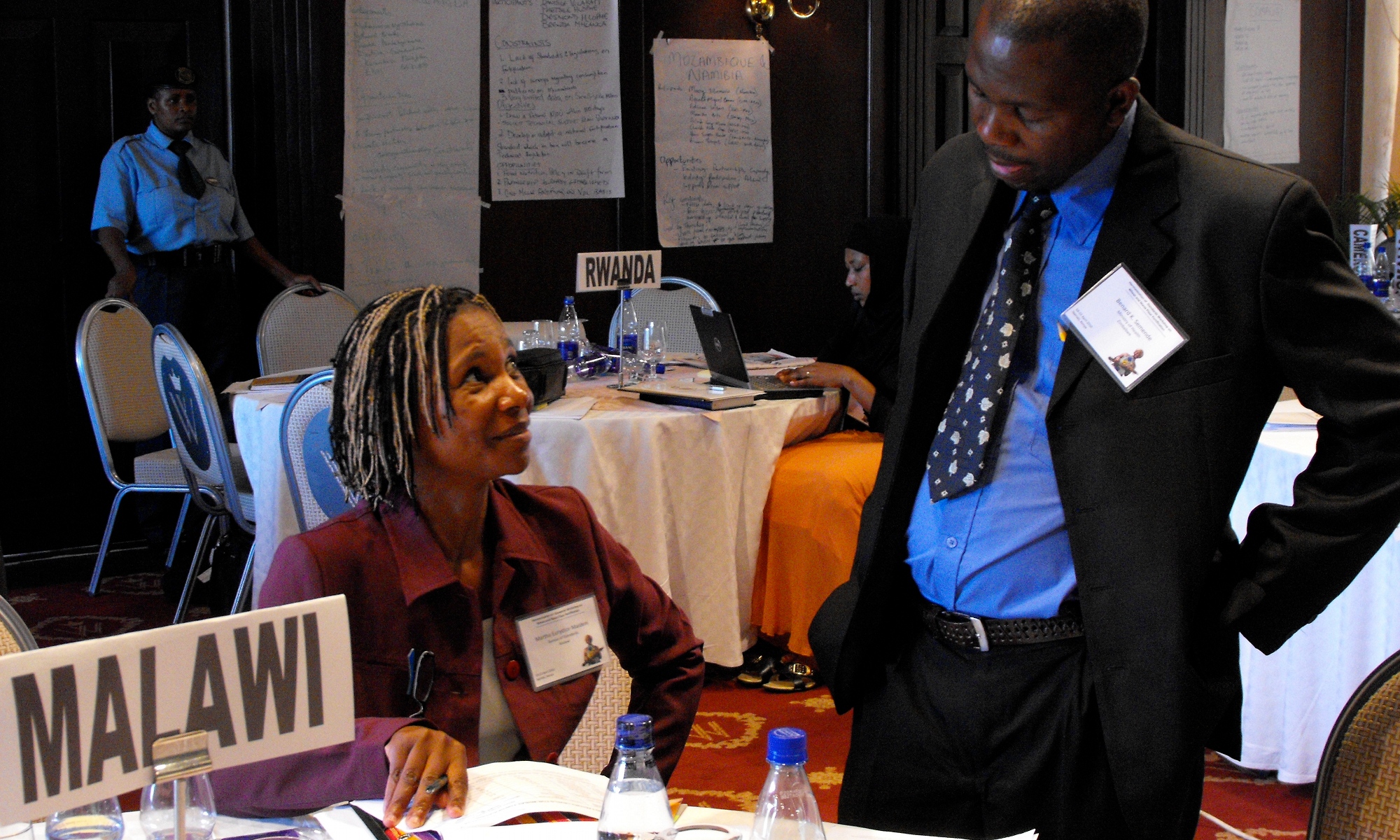19-22 April 2010
Where
Nairobi, Kenya
Agenda
Download the agenda, the concept note, as well as the summary from the workshop.
Participants
Click for the full participant list.
Evaluation
Click here for the evaluations.
Background
The importance of using the latest scientific data available for flour fortification – and contributing to the evolving evidence – became the focal point of a Harmonisation Workshop 19-22 April 2010 in Nairobi, Kenya. More than 100 people representing 15 African counties attended the workshop which was designed to help countries harmonize the World Health Organization (WHO) “Recommendations on Wheat and Maize Flour Fortification Meeting Report: Interim Consensus Statement” with their food consumption patterns, local milling infrastructure, and contextual realities such as whether other staple foods are effectively fortified. The workshop was organized by the Flour Fortification Initiative with support from Smarter Futures (a partnership with the Ministry of Foreign Affairs of The Netherlands); the United Nations Children’s Fund (UNICEF); the East, Central and Southern Africa Health Community (ECSA); Micronutrient Initiative (MI); Helen Keller International (HKI); World Bank, and World Food Programme.
The meeting began with reminders of the devastating effect of vitamin and mineral deficiencies. In the host country of Kenya, “statistics reveal a grim picture,” noted Ibrahim Amira, Deputy Director of Medical Services for Public Health and Sanitation, in a speech he presented on behalf of Shahnaaz Sharif, Kenya Director of Public Health and Sanitation. The vitamin A deficiency rate among children younger than 5 years is 76%, and iron deficiency affects 55% of pregnant women, he said. Vitamin and mineral deficiencies are present throughout the region, [1] and food fortification was presented as a strategy that can contribute significantly to optimizing maternal nutrition and young infant health.
In several Eastern, Central and Southern African countries, ECSA guidelines [2] are typically used to guide fortification of flour, oil, salt, and sugar. ECSA, which has direct links to regional health policy makers, based its guidelines on past recommendations from the WHO. However, the WHO released new guidelines for fortifying wheat flour in 2009. [3] During the workshop, ECSA encouraged countries to adapt the WHO recommendations as the latest available science for fortifying wheat flour with iron, folic acid, zinc, vitamin A, and vitamin B 12. [4] While flour is commonly fortified with other nutrients, these are the essential vitamins and minerals included in the 2009 WHO guidelines.
Many countries find it more economical and more practical to add vitamin A to edible oils than to wheat flour. Countries in West Africa are taking the lead in passing legislation to fortify flour with iron and folic acid and vegetable oil with vitamin A. Workshop participants were encouraged to consider this model, and to look at the West African example for managing imports and exports in areas where flour and oil are regularly traded.
Maize Fortification
The 2009 WHO guidelines apply to both wheat and maize flours for folic acid, vitamin A, and vitamin B12. The WHO guidelines apply to fortifying wheat flour with iron and zinc, but some uncertainty remains on appropriate levels for fortifying maize with iron and zinc. Several African countries are fortifying maize, and they were encouraged to systematically monitor their programs and contribute the information learned to the evolving evidence on maize flour fortification. One avenue for contributing to the on-going science is to reply to the WHO “Call for Public Comments” which seeks information for developing evidence-based policy and programme guidance for nutrition and health development.
Richard Hurrell, professor at the Swiss Federal Institute of Technology Institute of Food, Nutrition and Health, joined the workshop twice via a teleconference from Geneva. He suggested that the WHO recommendations for adding iron and zinc to low extraction wheat flour could be used for low phytate degermed maize flour. The WHO recommendations for adding iron and zinc to high extraction wheat flour could be used for maize with higher phytate content. He noted, however, that he knew of no published studies on the sensory effects of fortifying maize, and he stated that more work is needed in this area.
Sensory Properties
FFI and Smarter Futures are addressing this gap in information related to organoleptic effects by conducting cooking and baking trials in preparation for various meetings. Before this workshop, trials were conducted in South Africa and Tanzania using wheat and maize flours fortified at levels recommended in the WHO guidelines. Additional trials are being conducted in Kenya. Preliminary results from the trials showed no significant changes in the food’s sensory qualities. Foods prepared were bread and chapatti using wheat flour and porridge and ugali or posho using maize flour. While some slight differences were noted, all were deemed acceptable. The full report will be made available as soon as finalized.
During the workshop, dinner rolls were baked with wheat flour that had been fortified with iron, zinc, folic acid, and vitamin B12. Five pans of rolls were prepared; three with different kinds of iron and two with no fortificants to serve as control groups. Participants were challenged to find the differences in the rolls, but despite careful observations, only minimal differences were reported, and a few people said they liked the control group made with unfortified flour the least. [5]
Baking trials with wheat flour products were also done in East Asia in 2009 before a similar workshop in the Philippines. They likewise revealed that fortification caused only minimal sensory differences in commonly eaten foods such as various kinds of noodles. [6] These sensory trials, which used similar methodologies, contribute important new evidence on the feasibility and the acceptability of fortifying flours in accordance with the WHO guidelines. A review of 10 other studies on the organoleptic effects of flour fortification is available on the FFI website.
Consumption and Costs
In addition to paying attention to the effect of fortification on food properties, countries developing fortification plans should consider daily per capita flour consumption as noted in the WHO guidelines. Determining that figure can be challenging because a source of data is not always obvious. Five sources noted in the workshop are national food consumption data, household income and expenditure surveys which include information on staple foods, panel surveys, Fortification Rapid Assessment Tools (FRAT), and food balance sheets from the Food and Agriculture Organization. [7] Each source has limitations, but each represents an adequate option for gathering information. ECSA also offers a tool to be used for calculating flour consumption. [8]
Cost considerations are often cited as a hindrance to fortification. A panel of millers and another panel of premix suppliers addressed concerns related to the economics of fortification. In addition, the Global Alliance for Improved Nutrition (GAIN) presented information on its new service known as the GAIN premix facility. [9] Since launching in July 2009, the GAIN premix facility has delivered 32 premix orders, helping customers in 10 countries in Africa, Central Asia and Eastern Europe access affordable, quality certified vitamins and minerals. The value of orders is expected to reach US$4 million in value in the first full year of operation – it is estimated that once utilized, this premix will deliver essential micronutrients to approximately 60 million consumers in developing countries.
Country representatives were also challenged to consider the cost of not fortifying. A fortification plan for Tanzania estimates, for example, that the country loses at least $517 billion each year due to nutritional deficiencies. Fortification could be expected to avert at least a yearly $126 billion of those losses. When comparing the cost of fortification with the cost benefits, it is estimated that each 1000 Tanzanian shillings spent on food fortification would generate 8220 Tanzanian shillings in net savings. [10]
One afternoon session featured two breakout sessions. One session addressed quality assurance and control performed by mills and government authorities. [12] The second session was on the importance of monitoring the health impacts of programs. Both aspects – ensuring product quality and monitoring for effectiveness – are essential for fortification to maximize its potential for reducing the negative health consequences of vitamin and mineral deficiencies. Throughout the workshop, groups worked in country teams to apply the information being presented to their own situation. Each group developed a 100-day plan of action [13] to outline next steps for moving forward with flour fortification. After the workshop, partners working in Africa met to discuss how to support and facilitate the countries’ action plans. For many participants, this workshop was a follow-up to a 2008 advocacy meeting in Arusha, Tanzania. During that meeting, the group’s consensus statement was “Yes We Can!” Participants at the Harmonisation Workshop ending this meeting by declaring: “Yes We Will!” [14]
1. Overview of Micronutrient Issues And Action In The Eastern And Southern Africa Region
2. Flour fortification in the ECSA region and an overview of ECSA standards
3. Introduction to WHO Recommendations on Wheat and Maize Flour Fortification
5. Bread Tests
11. Quality Assurance and Control
12. Health impacts
- Cameroon
- Tanzania
- Ethiopia
- South Africa
- Kenya
- Malawi
- Mozambique and Namibia
- Rwanda
- Swaziland
- Uganda
- Zambia
- Zimbabwe
- Nairobi
Supporting documents
1. Africa Regional Reports:
- Combating Malnutrition in South Africa
- Regional Harmonization for Sustainable Food Fortification Program (ECOWAS Regional Feasibility Study)
- Summary of Recommendations and Next Steps for the East Central and Southern African Region
- Action Plan for the Provision of Vitamins and Minerals to the Tanzanian Population through the Enrichment of Staple Foods
2. Witamin B12, Zinc, Witamin A:
- Vitamin B12 fortification of flour
- Maternal Vitamin B12 Status and Risk of Neural Tube Defects in a Population
- Finger millet flour as a vehicle for fortification with zinc
- Vitamin A Fortification of Wheat Flour to Prevent Vitamin A Deficiency
- Zinc fortification of cereal flours: current recommendations and research needs
3. Economic Benefits:
- Copenhagen Consensus 2008 – RESULTS
- Cost-effectiveness of a folic acid fortification program in Chile
- The Economics of Food Fortification
- The economics of iron deficiency
- Reevaluating the Benefits of Folic Acid Fortification in the United States: Economic Analysis, Regulation, and Public Health
4. Folic Acid Studies:
- The Costa Rican Experience: Reduction of Neural Tube Defects following Food Fortification Programs
- FFI: Effectiveness, Safety and Economics of Fortifying Flour with Folic Acid
- Micronutrients, Health, and Development: Evidence-based Programs
- Folate and related B vitamins- An Evaluation of Adequacy from a European Perspective
- Reduction in Neural-Tube Defects after Folic Acid Fortification in Canada
- Decline in the Prevalence of Neural Tube Defects Following Folic Acid Fortification and Its Cost-Benefit in South Africa
- US CDC Grand Rounds on Folic Acid
- Will Increasing Folic Acid in Fortified Grain Products Further Reduce Neural Tube Defects without Causing Harm?: Consideration of the Evidence
5. Industry Tools:
- The Flour Millers Tool Kit on Fortification (English version)
- Trousse sur l’enrichissement à l’usage des minoteries (en francais)
- Marketing Flour Fortification: Examples from the Field
- Flour Fortification Millers Best Practices
- Recommended Practices for the Production and Procurement of Premix Used in Cereal Fortification Programs
6. Iron Studies:
- Development of the recommendations for the iron fortification of wheat flour
- Efficacy of Different Iron Fortificants in Wheat Flour in Controlling Iron Deficiency
- Efficacy of iron-fortified whole maize flour on iron status of schoolchildren in Kenya: a randomised controlled trial
- Comparison of the efficacy of wheat-based snacks fortified with ferrous sulfate, electrolytic iron, or hydrogen-reduced elemental iron: randomized, double-blind, controlled trial in Thai women
- The Use of Iron- fortified Wheat Flour to reduce Anemia in Sri Lanka
7. Monitoring Food Fortification in ECSA Region
8. Organoleptic Quality:
- Effect of Iron Source on Color and Appearance of Micronutrient-Fortified Corn Flour Tortillas
- Effects of various iron fortificants on sensory acceptability and shelf-life stability of instant noodles
- Quality of bread with 10 micronutrients
- Sensory acceptability and nutrient stability of double-fortified wheat flour
- Determination of visual detection thresholds of selected iron fortificants and formulation of iron-fortified pocket-type flat bread


